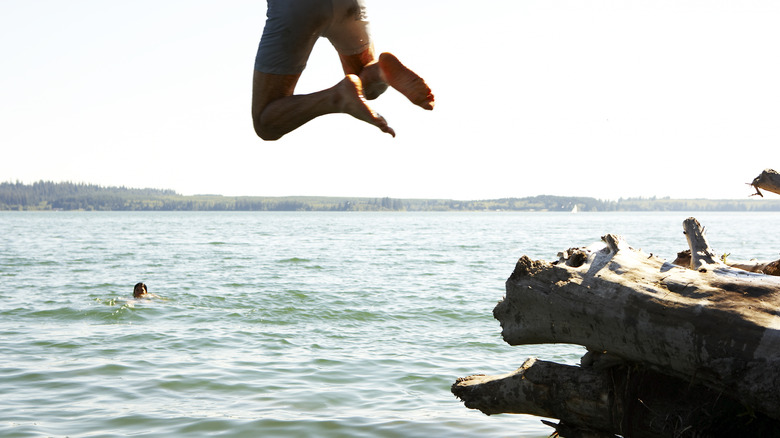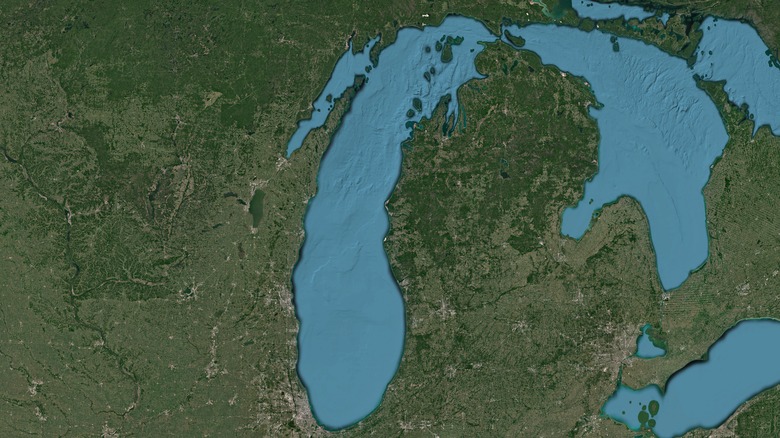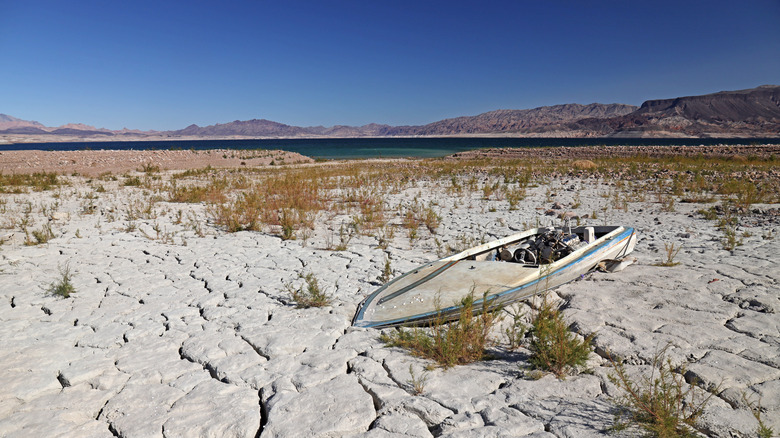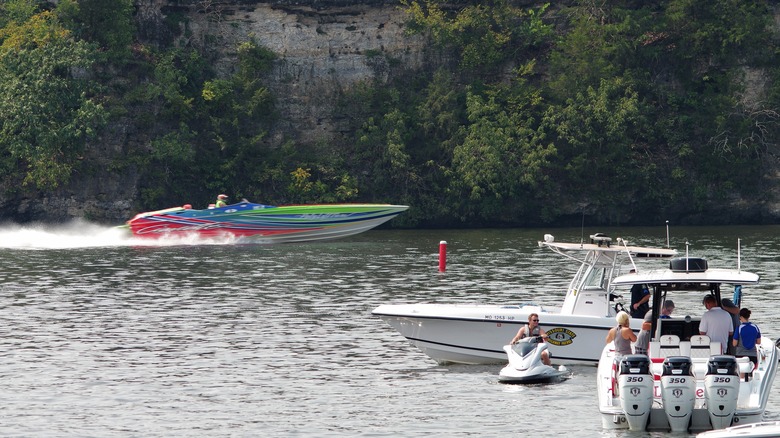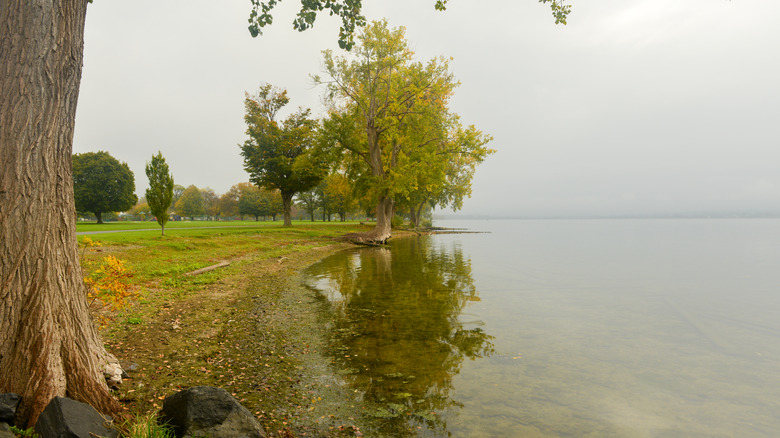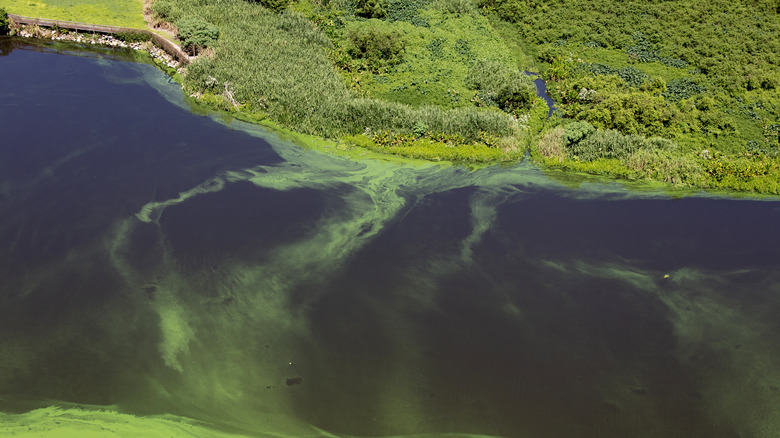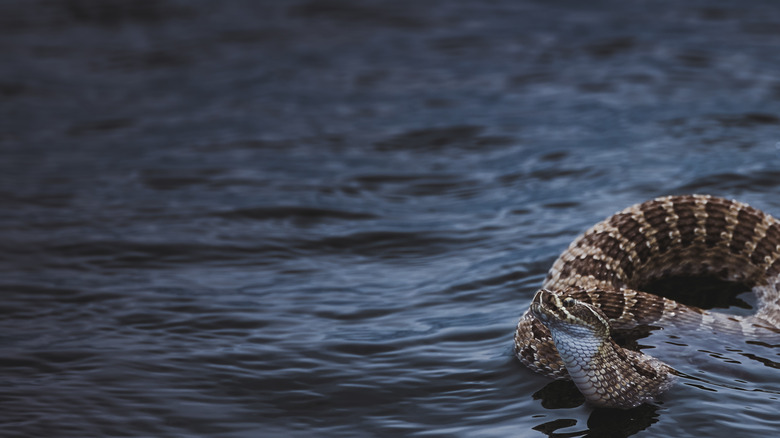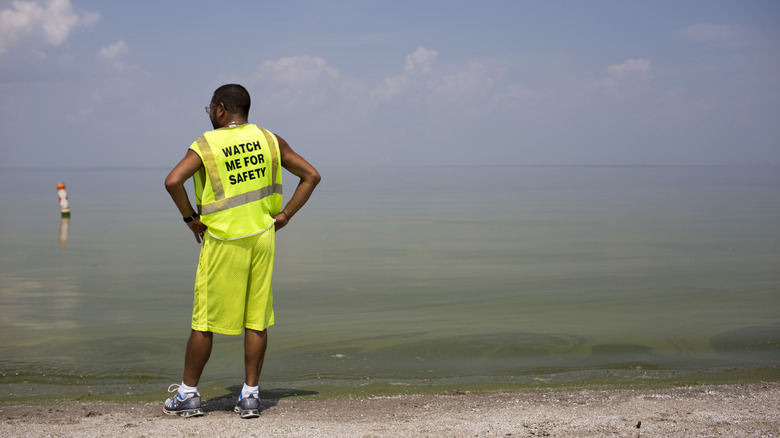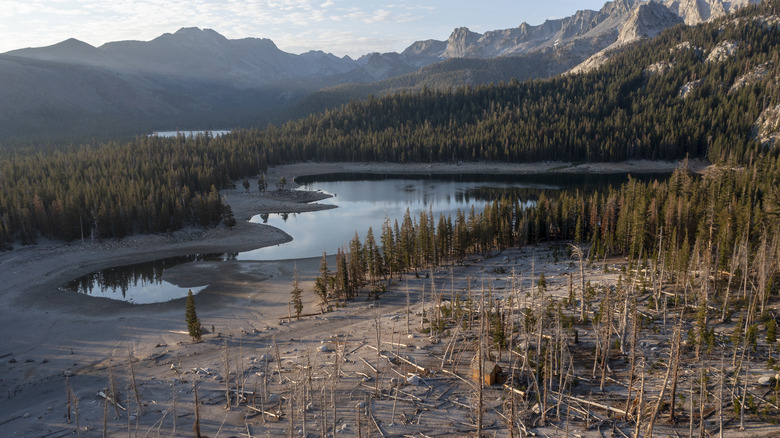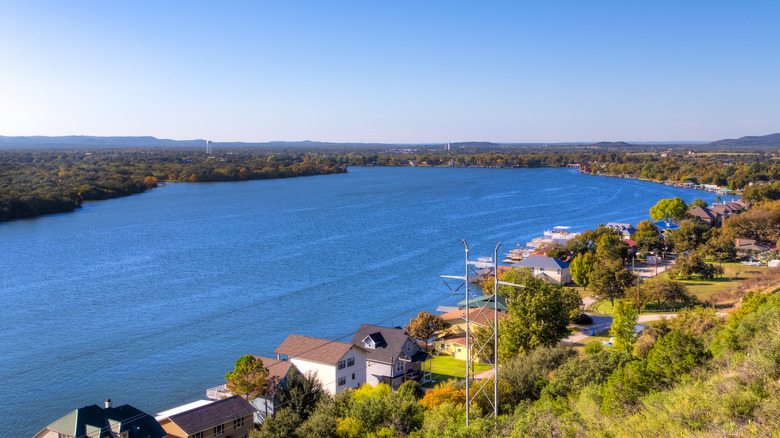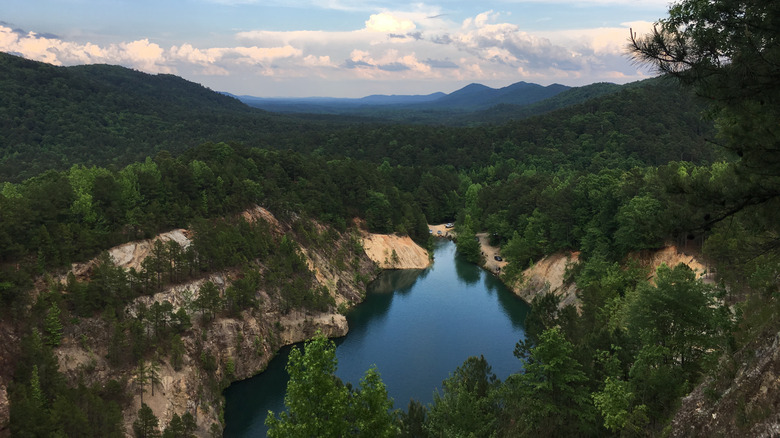Avoid Swimming In These Dangerous Lakes Across The US
Many of us have great memories of trips to the lake: refreshing dips on hot summer days, skipping stones with friends from the shore, or those creepy yet quiet moments when fog blanketed the area on cool nights. It's an escape to nature, particularly for those living inland who cannot easily make coastal getaways. But like any destination with water, you need to remain mindful of your surroundings and understand your limitations, especially in the most dangerous waters in the United States.
While lakes provide an idyllic scene, they can also harbor hidden dangers. According to the CDC, over 4,000 people die annually from drowning in the U.S., and more than half of these incidents involving people over 15 occur in natural water. Lakes, with their serene appearance, can mask several hazards that swimmers and outdoor lovers should be aware of. Beneath the tranquil water, powerful undercurrents or submerged structures ensnare unprepared swimmers. Toxic algae and microscopic brain-eating amoebae can silently lurk on the water's rim while monsters lurk underneath. These hidden threats may make you think twice before dipping your toes.
Lake Michigan has deadly currents
Since 2010, the Great Lakes have claimed over a thousand lives, according to stats compiled by The Great Lakes Surf Rescue Project (GLSRP), a nonprofit committed to advocating safe swimming practices and lifeguard training. But Lake Michigan is the most treacherous, averaging around 50 to 100 fatalities annually.
Lake Michigan spans 307 miles, only the third-largest Great Lake and the third-largest lake in the U.S. But its unique layout gives it unobstructed shorelines from north to south, making it particularly susceptible to swift and lethal currents. Dave Benjamin, executive director for GLSRP, told the Big Rapids Pioneer that currents play a significant factor. We typically think of rip currents, which quickly pull swimmers into deeper waters, and you're taught to escape by swimming parallel. However, these aren't the only kinds.
Longshore currents, generated when winds and waves hit the shoreline at an angle, can carry beachgoers away from safe entry points and fellow swimmers. Structural currents, formed near objects like piers and jetties, often hide beneath the surface, altering water flow patterns. And, of course, waves, which may look innocuous to beginners, have the potential to sweep swimmers away or collide with rocks unexpectedly.
Lake Mead has hidden danger
Lake Mead, a reservoir created by the Hoover Dam on the Colorado River, spans Nevada and Arizona. It holds the unfortunate record of having the highest fatality and drowning rates among all U.S. National Park sites, as reported by The Hill. According to an interview with park spokeswoman Christie Vanover in the Boulder City Review, the lake tragically witnesses as many as 12 drownings annually.
In addition to the inherent risks of open-water swimming, Lake Mead is characterized by fluctuating water levels and extreme drought conditions throughout the year. These lower water levels can bring submerged structures closer to the surface, posing dangers to unaware swimmers who might dive into unseen hazards and boats at risk of colliding with these structures — causing passengers to fall overboard into the water abruptly.
The National Park Service says that many drowning victims never intended to enter the water, and it's easy to underestimate the distance to the shore. Additionally, recreation at the lake is often paired with alcohol and a carefree attitude, potentially creating a hazardous mix. In response to a surge in unlawful behavior and fatalities in the summer of 2023, such as boating under the influence, Lake Mead officials issued a safety warning, as reported by Yahoo! News.
Lake of the Ozarks doesn't have daytime speed limits
The darker side of Lake of the Ozarks isn't entirely sensationalized. As reported by Kansas City news, areas have seen a 300% surge in felony crime, a trend law enforcement attributes to tourism. However, boating accidents also contribute to the lake's reputation for danger. The Lake of the Ozarks, according to Lt. Eric Kiehlmeier, U.S. Coast Guard Sector Upper Mississippi River chief of prevention, "is one of the most dangerous lakes in America due to the high number of fatal boating accidents."
The lake draws millions of visitors annually. This influx of visitors translates into a substantial increase in boat traffic, particularly during weekends. Predictably, not everyone has expert boating skills. The influx of inexperienced boaters, often piloting rental vessels, coupled with alcohol consumption both on the water and at lakeside bars, further exacerbated by limited law enforcement, heightens the danger at the lake.
To make matters worse, Lake of the Ozarks has no official daytime speed limit. While law enforcement can cite boaters for reckless speed, overall, safety largely depends on the discretion of individual drivers, which is not exactly prudent for people who are absolutely smashed and trying to impress a boat full of friends. The only official speed restriction is a nighttime limit of 30 mph. Speeding is so prevalent on the lake that it has gained notoriety for drag-racing culture. It is even home to the Shootout, self-described as the largest unsanctioned boat race in the U.S.
Onondaga Lake is still polluted
Onondaga Lake, on the outskirts of Syracuse, New York, was among America's most polluted lakes for decades. In the 19th century, industrial expansion and tourism caused mass pollution and runoff (such as highway salt, fertilizers, and pesticides) in the lake. Eventually, swimming was banned in 1940 and fishing in 1970. Millions of marine life and waterfowl died from high mercury and nitrogen levels, raw sewage, and toxic algal blooms.
After decades of cleanup, swimming and fishing were permitted, and Onondaga officials have said the lake is now the cleanest it has been in over 100 years. Nevertheless, many people, including the Onondaga Nation, doubt the lake's safety. The Onondaga Nation is historically linked to the land around Onondaga County, and the Onondaga Reservation is located only about 10 miles south of the lake.
While the Onondaga government asserts the safety of swimming in the lake, much of the public and representatives from the Onondaga Nation have expressed doubts. In an interview for The News House, Onondaga Nation representatives argue that toxic chemicals persist in the lake sediment. Alma Lowry, Onondaga Nation's environmental attorney, has said the situation is "an industrial waste landfill on the bottom of a lake." As reported by Syracuse.com, Jamesville Beach was closed by the Onondaga County Health Department in July 2023 due to algal blooms. These blooms, stemming from wastewater and runoff, can release toxins that may lead to skin or eye irritation, diarrhea, and vomiting if ingested.
Lake Okeechobee has toxic algae, gators, and sharks
Lake Okeechobee, the largest lake in Florida, is another unfortunate pollution case. The main culprit is agricultural pollution from pesticide and fertilizer runoff carrying nitrogen and phosphorus nutrients. As these nutrients infiltrate water, they foster an ideal setting for eutrophication — water so enriched with nutrients that it stimulates algae and cyanobacteria growth called algal blooms.
According to NASA Earth Observatory, these swirling patches of slimy blue-green algae can extend over half of Lake Okeechobee's total surface area. Apart from wreaking havoc on the local ecosystem, oral exposure (like the kind you'd get from swimming) can cause serious health issues. According to a 2022 study published in the journal Toxins, study subjects (mice, in this instance) showed signs of liver inflammation and gut disorders. Algal blooms are common in Lake Okeechobee, leading to frequent advisories from The Florida Department of Health cautioning against swimming.
And if poison muck isn't thrilling enough, you can add the occasional man-eater to the mix. Based on data collected by the Florida Fish and Wildlife Conservation Commission for annual alligator harvest suggests Lake Okeechobee has the highest population (638 in 2022 alone) of alligators in Florida. Gators love shallow waters; despite its size, Lake Okeechobee is only nine feet deep. Florida, in general, averages eight alligator attacks per year. Finally, like a low-budget horror film that gets crazier with every sequel, even bull sharks have been spotted in Lake Okeechobee.
Okemah Lake has rattlesnakes
Did you know rattlesnakes could swim? A man discovered that firsthand in June 2023 while pontooning on Okemah Lake in Oklahoma. According to Fox 23 News, he was floating in the middle of the lake when a pygmy rattler decided to ruin his day with a nasty bite. Thankfully, he kept a cool head and immediately sought medical attention. Okemah Lake officials called the snake in the middle of the lake "a little odd," but is it really?
In May 2023, Newsweek reported a similar incident of a rattlesnake swimming in California's Lopez Lake. In July, East Idaho News reported that a nine-year-old girl suffered a snakebite while swimming in Idaho's Blacktail Lake. In August 2022, the Texas Parks and Wildlife Department shared a video of a diamondback gliding across the surface of O.H. Ivie Lake near San Angelo, Texas. Fishermen on Lake Oahe in South Dakota see rattlesnakes occasionally slithering onto their boats.
Arizona, which has 13 rattlesnake species, more than any other state, sees its fair share of rattlesnakes on Lake Pleasant, as reported by ABC15 Arizona. Rattlesnakes take to the water to hunt, evade threats, or try to cool off. They might even fall from the skies, courtesy of a clumsy bird of prey (so heads up). Plus, don't assume you'll see them coming. According to the AAAC Wildlife Removal, rattlesnakes can remain submerged for up to 45 minutes without needing to surface for air.
Lake Erie has a dead zone
Dr. Seuss once wrote, "They will walk on their fins and get woefully weary in search of some water that isn't so smeary. I hear things are just as bad in Lake Erie." He wasn't just making a silly rhyme. The "smeariness" Seuss alluded to was algal blooms that plagued Lake Erie due to eutrophication. After dead fish started washing up on the shores of the lake, the phrase "Lake Erie is dead" started spreading during the late 1960s.
Half a century later, Lake Erie still isn't doing great. Annually, between July and October, vast parts of the lake become enveloped in cyanobacteria or blue-green algae. This disrupts the ecosystem and poses health risks such as skin irritations, nausea, and disorientation, and can even kill your pets. And according to the National Park Service, it reeks. Moreover, once the blue-green algae decomposes, it sinks to the bottom of the lake and consumes oxygen in the water. The low oxygen levels make an area called a "dead zone" because any aquatic life that can't get out of the zone will die.
While it wasn't well studied what made Lake Erie turn smeary back then, we do know the sources of algal blooms are man-made: industrial waste, sewage, lawn fertilizer, and agriculture pollution. Perhaps if he'd known, Dr. Seuss would have rhymed something else, like things are smeary in Lake Erie thanks to human greed making blue-green algae.
Horseshoe Lake has toxic gas
In 1989, the serene Horseshoe Lake, nestled under California's Mammoth Mountain, experienced a quake that opened magma channels, releasing carbon dioxide into the air. According to the U.S. Department of Agriculture, the gas is dense enough to collect in pockets and enclosures. This rendered the area unsafe and decimated 120 acres of trees around the lake and on Mammoth Mountain. However, research has found that CO2 levels change depending on the season. More snow and water pressing on the mountains squeeze the fault shut like a gate.
Fortunately, during the summer months—when the allure of swimming is arguably strongest—the CO2 levels around Horseshoe Lake remain closer to the ground. According to the U.S. Geology Survey, the area is safe enough for everyone, even children and pets, with the caveat that everyone keeps their heads above ground level. However, in winter, CO2 levels build beneath the snow and escape in large bursts through tree wells, around large rocks, and buildings.
Still, the risks are real. In 2006, The Washington Post reported that three ski patrol members tragically died after falling into a snow cave and succumbing to poisonous gases. Eight years earlier, according to the Los Angeles Times, a cross-country skier was found dead near the lake from carbon dioxide poisoning. According to the CDC, carbon dioxide poisoning symptoms are "flu-like" and include headache, dizziness, weakness, upset stomach, vomiting, chest pain, confusion, and, eventually, loss of consciousness.
Lake Lyndon B. Johnson has brain-eating amoeba
Lake Lyndon B. Johnson (or Lake LBJ) in Texas is known for having a consistent water level, making it popular for swimmers and boaters. However, Lake LBJ and other lakes sometimes contain a dangerous and invisible threat. Naegleria fowleri is a microscopic amoeba found in freshwater and soil. It's called the "brain-eating amoeba" because it enters your nose, travels to the brain, and kills brain tissue. It is almost always fatal.
As reported by KSAT-TV, a swimmer died in September 2023 after swimming in Lake LBJ and falling ill. Austin authorities confirmed they were a victim of Naegleria fowleri. Symptoms are severe, including confusion, inattentiveness, seizures, and hallucinations, and death can occur as quickly as five days. According to the Texas Department of State Health, infections are rare but more likely during summer. Brain-eating amoeba live in warm water (80 degrees or more), particularly in the humid South. Since 1962, Texas (39 cases) and Florida (37 cases) lead in infections.
The Brazos River Authority in Texas often cautions swimmers to be wary of Naegleria fowleri in open water. Authorities recommend swimmers use nose clips or refrain from submerging their heads, staying out of and not disturbing ground underwater as the amoeba can reside in the soil. To make matters worse, Lake LBJ has been experiencing toxic blue-green algae. During the summer of 2023, the Lower Colorado River Authority identified high toxicity levels in algae samples from three locations on Lake LBJ.
The Blue Hole could have anything in it
In Arkansas, the Blue Hole is an old rock quarry that locals call a hidden gym. Some might find swimming in a quarry a bit backwoods. Still, it evokes nostalgia for many Americans — especially those living in the rural South. It's like an oasis on a sweltering summer day, and, thanks to high pH levels and minerals, it can appear an inviting turquoise color. However, the image of carefree dives and weekend swims conceals the inherent dangers.
Most rock quarries are abandoned. There is no telling how deep, shallow, or cold the water is. You might dive into depths so deep and freezing that you immediately panic or experience shock. Or you might dive onto a slab of stone or the hood of a car. Rock quarries are frequent illegal dumping grounds. According to Geology.com, 278 people died in mines and quarries across the U.S. between 2001 and 2017, and the leading cause of death was drowning. As reported by the Arkansas Democratic Gazette, a teen drowned in Arkansas's Blue Hole in 2017.
Moreover, it's illegal to enter, as reported by THV11. The landowner where the Blue Hole is situated banned visitors from entering in 2019. Although they never explicitly stated why, locals believe it was due to excessive garbage. A diver searching the Blue Hole for lost items returned only with beer cans and gun shell casings. Alcohol and guns in the woods probably didn't make things safe either.
